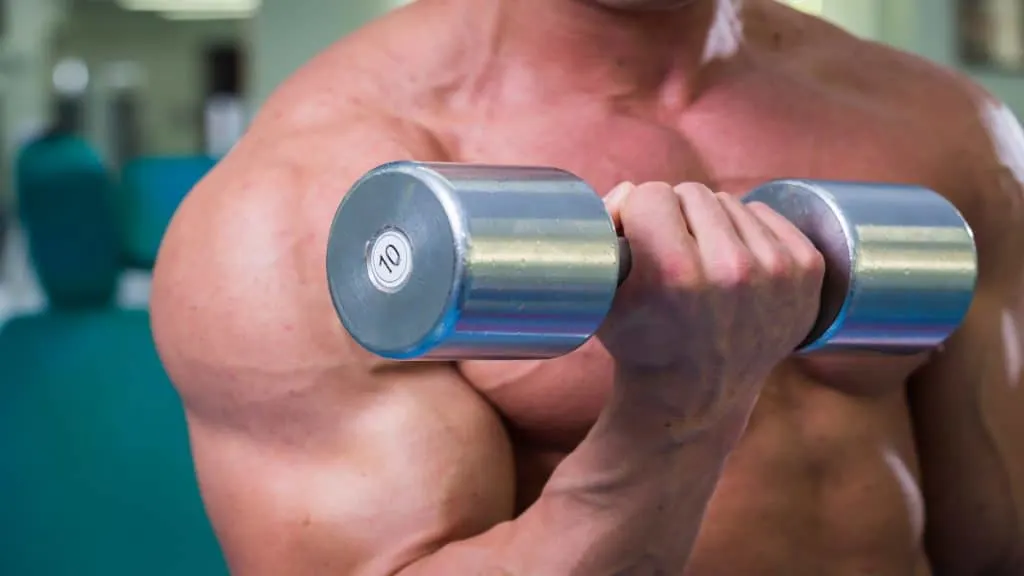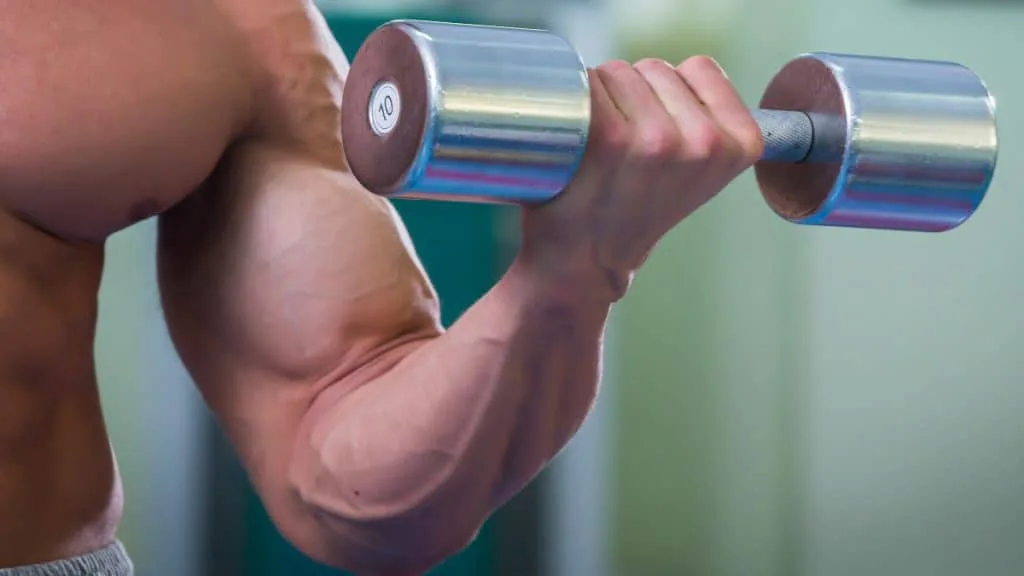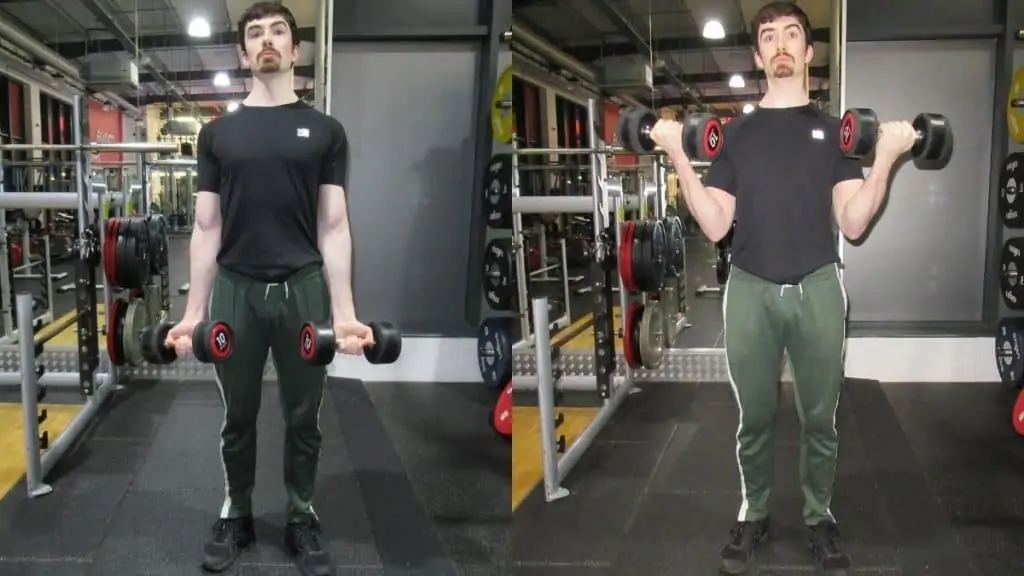Are 10 pound bicep curls enough to build muscle? Also, how much should I be able to curl?
Whether you can only curl 10 lbs or whether you only have access to 10 lb dumbbells, this guide will show you how to challenge your biceps with nothing more than a pair of 10 lb weights.
You can see our main page for the biceps muscles if you want to check out our exercise tutorials, or you can see the links below for similar articles on various curling weights and how to maximize them.
Are 10 pound bicep curls enough to build muscle?

If you can bicep curl 10 lbs, then that’s enough weight to build muscle in many cases. There’s no rule that says 10 lb curls have to feel like 10 lb curls. You can make the resistance seem much more challenging by applying various intensity techniques.
For example, you can perform slow-negatives to increase the time under tension that your biceps have to handle. [1] This tactic is effective for building size because muscles respond and grow from tension, not weight (muscles don’t even know what “weight” is because they’re simply pieces of meat).
Additionally, you can hold the weight for 3-5 seconds at a challenging part of the rep (when your elbow is at a 90-degree angle) in order to make your biceps burn and prolong the set.
Also, pay attention to your form. It’s much better to perform fewer reps with strict technique than it is to do loads of sloppy reps with poor form.
Finally, if you only have 10 lb dumbbells, then the best way to build your biceps is to perform plenty of reps per set. If you can do 100 curls with 100 lbs, then that’s a great way to build muscle in a short space of time.
Why can I only curl 10 pounds?

If you can only curl 10 pounds in each hand, then that’s obviously because your biceps lack the strength to curl heavier weights.
Perhaps you’re a weight lifting beginner?
Those with skinnier starting points might not be able to lift much weight initially. But if you’re disciplined enough to stick to weights that your biceps can handle, it won’t take long before you’re curling in excess of 10 lbs with the optimal bicep-building technique.
Women, in general, have much weaker arms than men (things are closer when it comes to the legs). [2] So if you’re a woman who can only curl 10 pounds, then you shouldn’t be too hard on yourself because that’s a decent amount of weight to lift if your reps are high and your form is on point.
Are 12 lb curls good?

You might not think that there’s a whole lot of difference between 10 pound curls and 12 pound curls because the weight difference is only 2 lbs.
However, that seemingly small 2 lb difference represents a massive 20% weight increase.
Just imagine how hard it would be to increase your bench press or squat working weight by 20% in one go!
It would be very difficult indeed. For this reason, you often need to do at least 12 reps with 10 lb dumbbells before you’re able to do 12 lb biceps curls for even a few hard-earned reps.
Don’t get tempted to jump straight to 15 lbs because that’s a 50% weight increase. When you start to see the percentage increase between weights, you also begin to realize that seemingly small weight jumps are actually a sign that your biceps are becoming significantly stronger.
10 pound dumbbell curl case studies
Learn what kinds of people can perform 10 pound bicep curls and how they made the best use of the weight to train their biceps.
Case study 1: DT
The man behind the YouTube channel DT posted an eye-opening video of himself curling 10 lb dumbbells for 50 reps.
This just goes to show that high reps can work wonders for the biceps if you’re prepared to train close to failure.
When you lift heavy, you’re, by definition, already close to failure.
But when you lift lighter weights, it’s important to really push toward failure in order to recruit as many muscle fibers as possible. This is because the initial repetitions in a high rep set aren’t challenging enough to create much in the way of muscle growth.
Case study 2: User Unknown
The lady behind the YouTube channel User Unknown posted a video of herself back in 2014 doing 10 lb bicep curls with excellent form.
Seriously, if you want to know what good bicep-building technique looks like, watch her video. I know a few ego lifters who could learn a thing or two from her!
Unlike most people you see lifting weights at the gym, this lady used a complete range of motion to challenge and change her biceps. She lifted the dumbbell all the way up for a full, intense contraction and then lowered the weight all the way down until her elbow reached full extension.
That’s what you call a proper bicep curl.
Notice also how she worked each arm separately. This is called unilateral training, and it enables you to focus more intensely on each of your biceps to get the possible hypertrophic stimulus (because you don’t need to split your focus between two limbs).
Conclusion: Is curling 10 pounds good or not?

10 pound bicep curls might not seem like enough of a challenge to produce results. But as I’m fond of saying, your muscles can’t read the number on the side of the dumbbells, and so they can’t tell how much weight you’re curling.
That’s because muscles are simply pieces of meat that respond to the tension that you put them under.
So can you build your biceps with nothing more than 10 lb curls?
Yes, absolutely. If you train close to failure with good form and do 3-5 sets, then you’ll definitely see noticeable bicep gains if you curl 10 lb dumbbells consistently.
References
- Vaglica, J. (2020, April 22). Positively Powerful Arms With Slow Negative Reps. Bodybuilding.Com. https://www.bodybuilding.com/content/positively-powerful-arms-with-slow-negative-reps.html
- Miller, A. E. J., MacDougall, J. D., Tarnopolsky, M. A., & Sale, D. G. (1993). Gender differences in strength and muscle fiber characteristics. European Journal of Applied Physiology and Occupational Physiology, 66(3), 254–262. https://doi.org/10.1007/bf00235103

